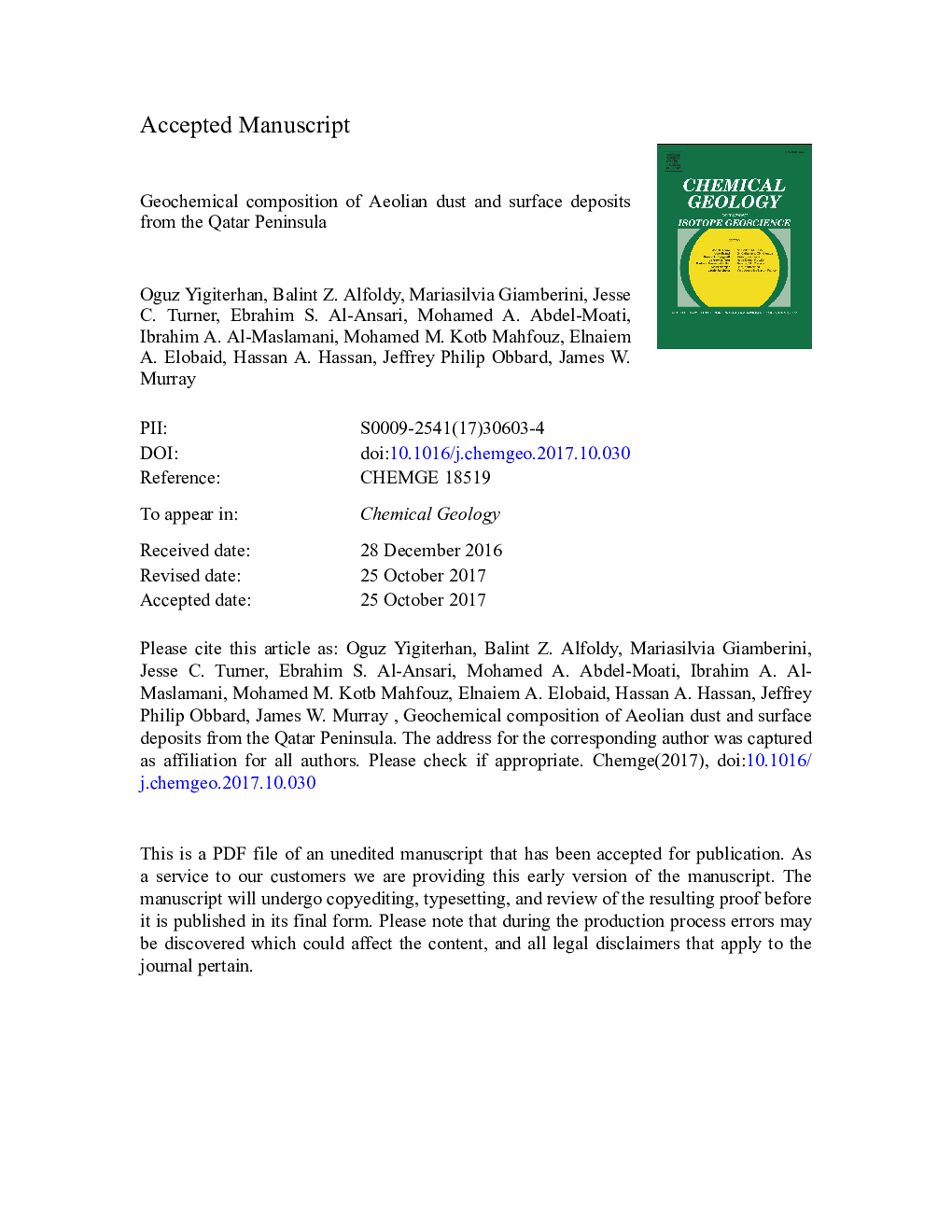| کد مقاله | کد نشریه | سال انتشار | مقاله انگلیسی | نسخه تمام متن |
|---|---|---|---|---|
| 8910444 | 1637498 | 2018 | 48 صفحه PDF | دانلود رایگان |
عنوان انگلیسی مقاله ISI
Geochemical composition of Aeolian dust and surface deposits from the Qatar Peninsula
ترجمه فارسی عنوان
ترکیب ژئوشیمیایی گرد و غبار ائولین و رسوبات سطح از شبه جزیره قطر
دانلود مقاله + سفارش ترجمه
دانلود مقاله ISI انگلیسی
رایگان برای ایرانیان
کلمات کلیدی
Dust collection - جمع آوری گرد و غبارArabian Gulf - خلیج فارسAtmospheric deposition - رسوبات جویArabian Peninsula - شبه جزیره عربیMajor elements - عناصر اصلیTrace elements - عناصر ردیابیEnrichment factors - فاکتورهای غنی سازیTrace metals - فلزات کمیابContinental crust - پوسته قاره ایaeolian dust - گرد و غبار aeolian
موضوعات مرتبط
مهندسی و علوم پایه
علوم زمین و سیارات
ژئوشیمی و پترولوژی
چکیده انگلیسی
The trace metal geochemistry of atmospheric dust and terrestrial surface particles were studied on the Qatar Peninsula from February 2014 to November 2015. We included samples of the mega dust-storm event on 01-02 April 2015. Atmospheric dust samples were collected using passive dust traps. Terrestrial surface deposits of recent dust accumulation and traffic particulate from roads were also sampled. All samples were total acid digested and analyzed for major and trace elements using ICP-OES analyzer. The concentration of thirteen elements (Ca, Mg, Ag, As, Cd, Cr, Cu, Mo, Ni, Se, Sn, Sr, Zn) were enriched in atmospheric dust samples, relative to upper continental crust (UCC). Calcium was especially enriched by up to 435% relative to UCC. About 33% of the total sample mass was CaCO3, reflecting the composition of surface rocks and soils in the source areas. Of the elements typically associated with anthropogenic activity, Ag, Ni, and Zn were most enriched relative to UCC, with enrichment factors (EF) of 182%, 233%, and 209%, respectively. Other metals, which normally reflect anthropogenic sources, including Pb and V, were not significantly enriched, with enrichment factors of 25% and 3%, respectively. Major elements (Al, Mn, Fe) were depleted (â 58%, â 35%, and â 5%, respectively) relative to UCC due to the large dilution effect of the enrichment of CaCO3. Back trajectories were determined at the date of sampling for each sample using the NOAA HYSPLIT model. These showed that the source of the dust particles was almost equally divided between northerly and southerly sources, except one sample, which appeared to originate from the west. More variability in particle source locations were observed during the winter months (October to March). Samples from the mega-dust storm were solubilized using an acetic acid-hydroxylamine hydrochloride leach procedure to obtain an upper estimate of the potential contribution of bioactive elements to surface seawater. The leach procedure solubilized a significant fraction of almost all elements. Ca was the element most affected (81% removed) because of the carbonate minerals present. Bioactive elements like Fe (25%) and P (58%) were also significantly solubilized. Because river input is so small to the Arabian Gulf, this solubilized fraction of dust is likely a major source of nutrients to surface seawater. Enrichment factors were also calculated with respect to the average composition of terrestrial surface deposits (TSD). Samples are not enriched significantly with respect to major components (EF < 2), with a depletion in Ca, K, Na in dust storm samples, reflecting a different origin. A significant enrichment of the same trace metals is evident in dust deposits and in traffic samples, but not in dust storms: Cu, Mo, Ni, Zn, possibly deriving from local atmospheric sources (traffic, industries). Samples with northern and southern origins were compared to see if the composition could be used to identify source. Only three elements were observed to be statistically different. Pb and Na were higher in samples from the south, while Cr was higher in those from the north.
ناشر
Database: Elsevier - ScienceDirect (ساینس دایرکت)
Journal: Chemical Geology - Volume 476, 5 January 2018, Pages 24-45
Journal: Chemical Geology - Volume 476, 5 January 2018, Pages 24-45
نویسندگان
Oguz Yigiterhan, Balint Z. Alfoldy, Mariasilvia Giamberini, Jesse C. Turner, Ebrahim S. Al-Ansari, Mohamed A. Abdel-Moati, Ibrahim A. Al-Maslamani, Mohamed M. Kotb, Elnaiem A. Elobaid, Hassan M. Hassan, Jeffrey P. Obbard, James W. Murray,
